
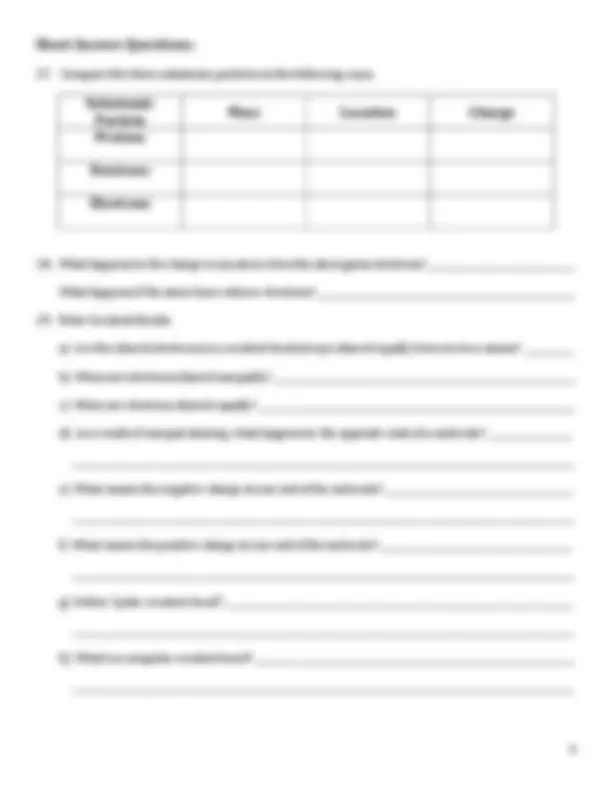
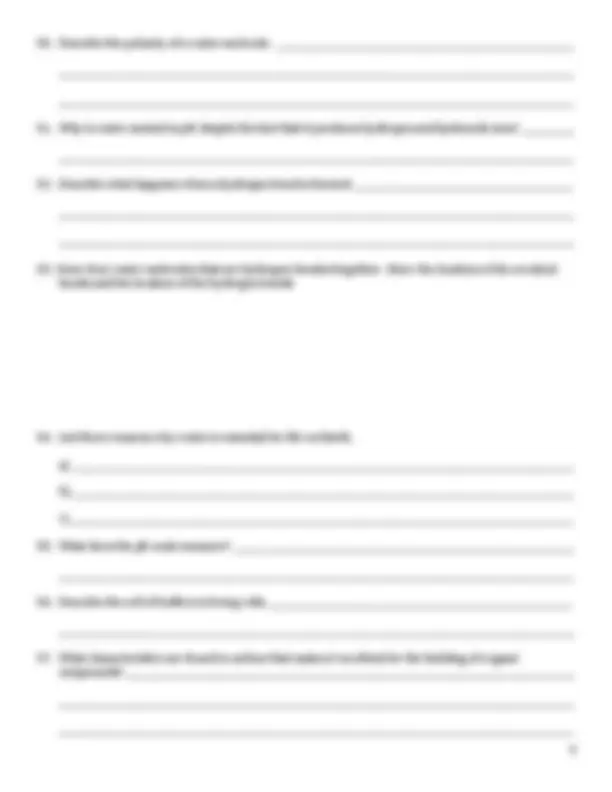
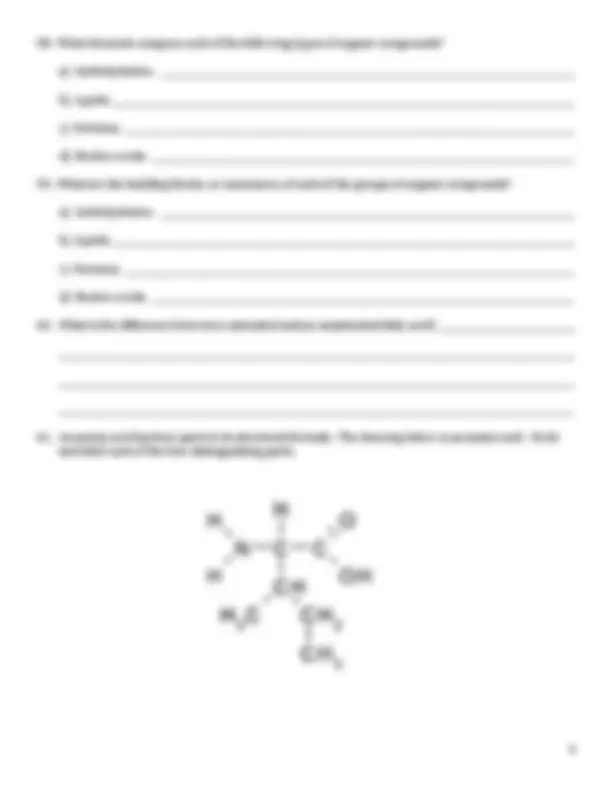
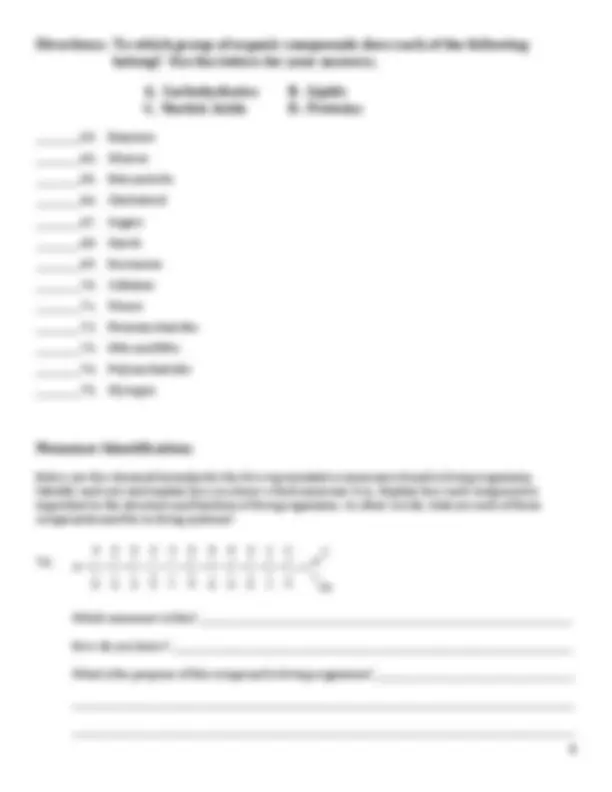
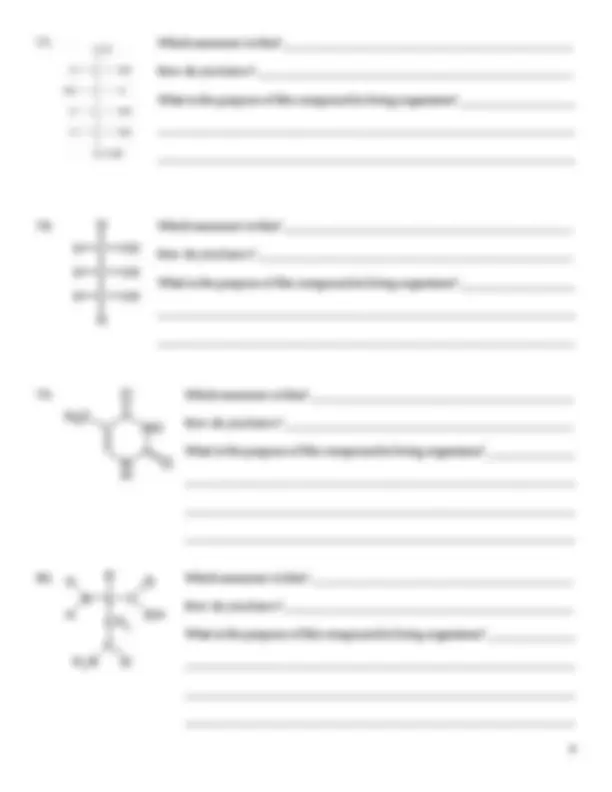
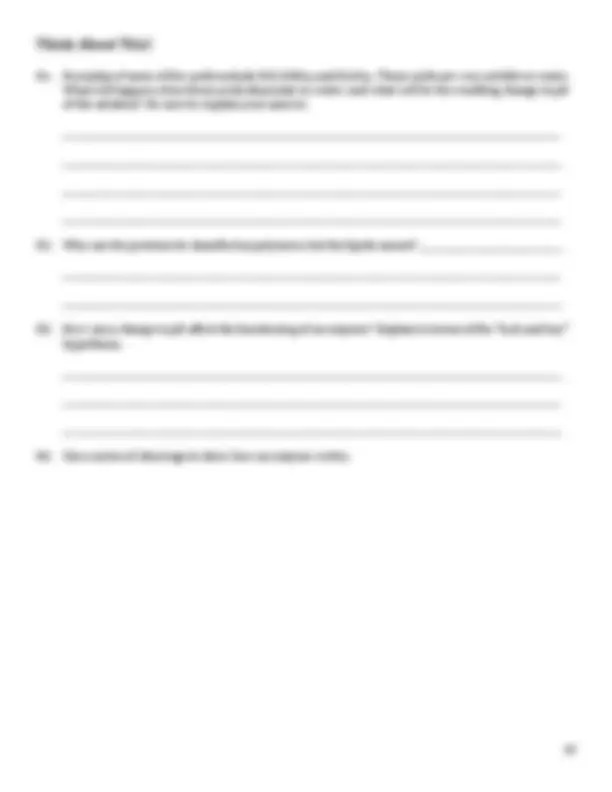
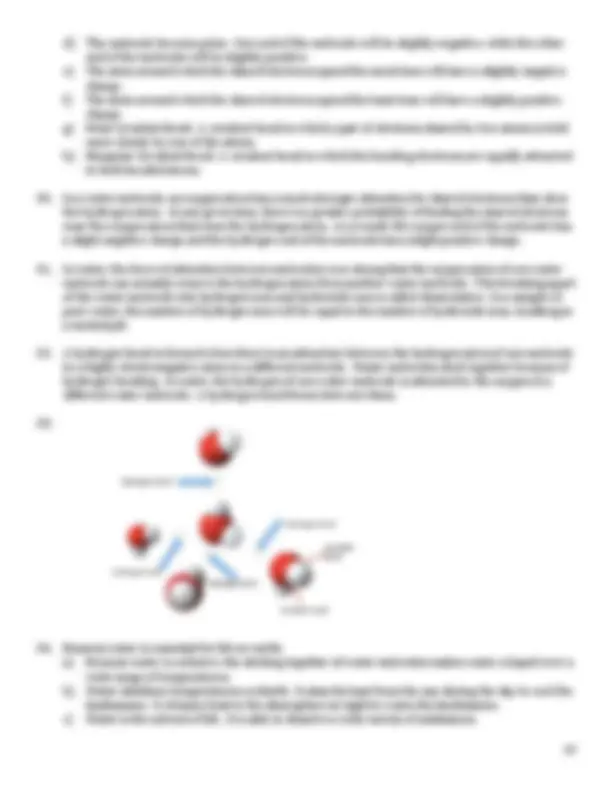
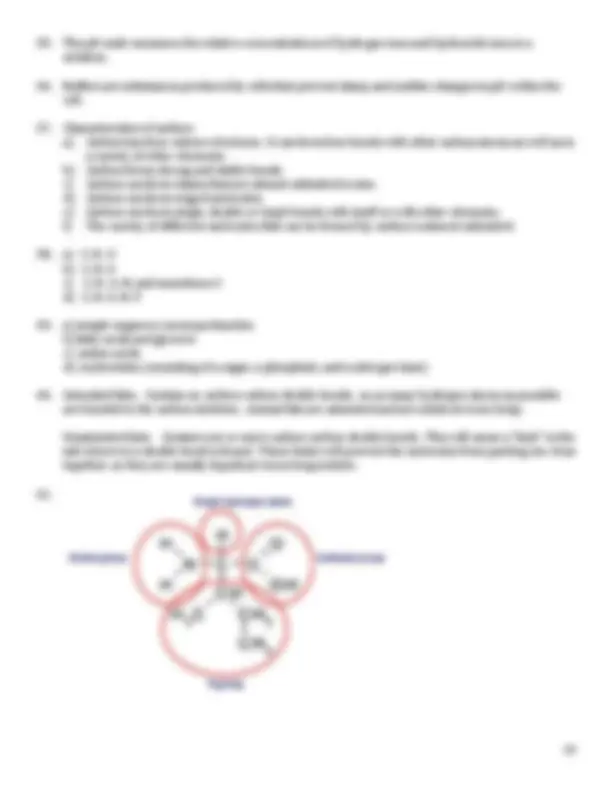
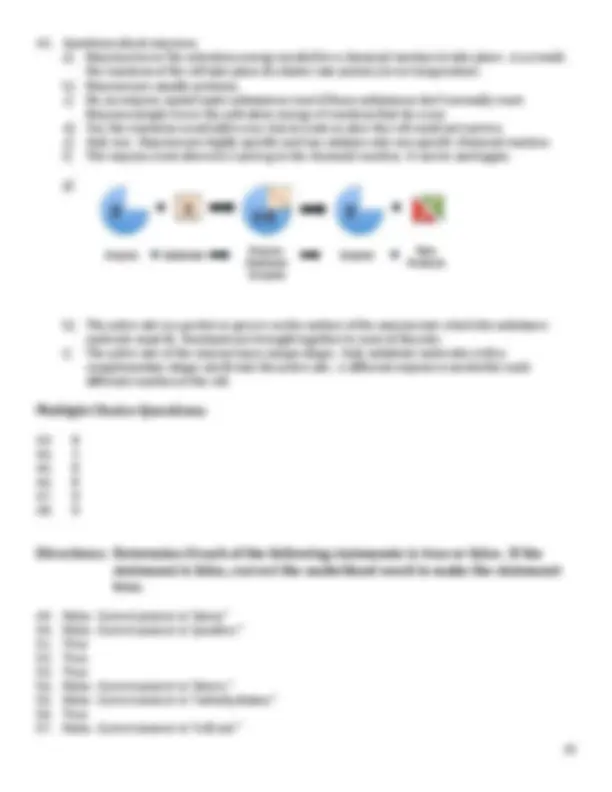
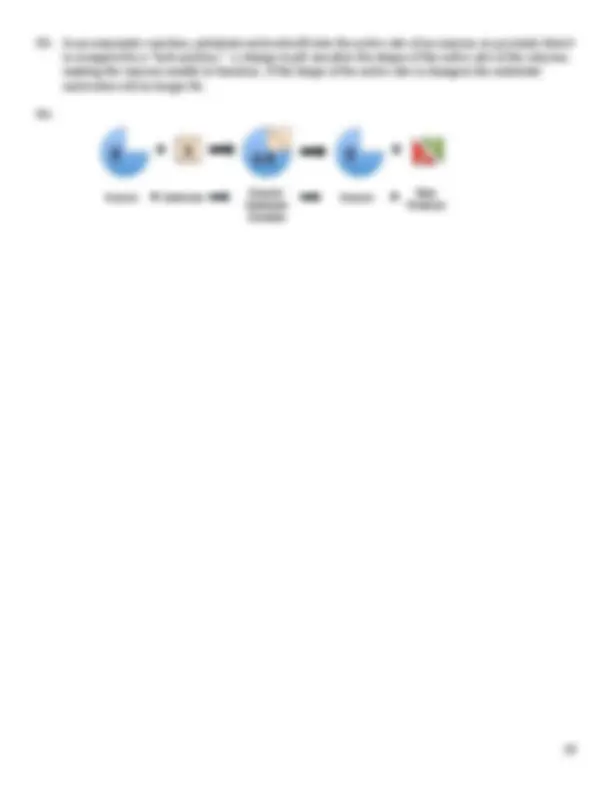


Study with the several resources on Docsity

Earn points by helping other students or get them with a premium plan


Prepare for your exams
Study with the several resources on Docsity

Earn points to download
Earn points by helping other students or get them with a premium plan
Community
Ask the community for help and clear up your study doubts
Discover the best universities in your country according to Docsity users
Free resources
Download our free guides on studying techniques, anxiety management strategies, and thesis advice from Docsity tutors
Live matter chemistry is called biochemistry. 84 questions with answers in the end are included in this worksheet
Typology: Exercises
1 / 18

This page cannot be seen from the preview
Don't miss anything!












On special offer
Name ______________________________________________
Date _________________
____________________________11. The smallest particle of a substance that still retains the properties of that substance. ____________________________12. List the three subatomic particles that compose atoms.
____________________________13. The atoms in a compound are held together by chemical bonds. What part of the atom is involved in the bonding process? ____________________________14. This type of bond is formed when electrons are transferred from one atom to another. ____________________________15. This term describes an atom that has lost or gained valence electrons.
____________________________16. This type of bond is formed when electrons are shared between two atoms.
____________________________17. Type of mixture in which the parts are evenly mixed.
____________________________18. Type of mixture in which the parts are unevenly mixed.
____________________________19. What term describes a mixture of water and undissolved materials that are so small they do not settle out? ____________________________20. What term is used to describe “giant molecules”?
____________________________21. List the four groups of organic compounds.
____________________________22. The storage form of excess glucose in plants.
____________________________23. The storage form of excess glucose in animals.
____________________________24. Name of the stringy, fibrous material that serves as a strengthening tissue in the cell walls of plants. ____________________________25. Proteins that speed up chemical reactions inside of cells.
____________________________26. What are the two types of nucleic acids?
a) _________________________________________________________________________________________________________________
b) _________________________________________________________________________________________________________________
c) _________________________________________________________________________________________________________________
a) Carbohydrates: _____________________________________________________________________________________________
b) Lipids: ________________________________________________________________________________________________________
c) Proteins: _____________________________________________________________________________________________________
d) Nucleic Acids: _______________________________________________________________________________________________
a) Carbohydrates: _____________________________________________________________________________________________
b) Lipids: ________________________________________________________________________________________________________
c) Proteins: _____________________________________________________________________________________________________
d) Nucleic Acids: _______________________________________________________________________________________________
_________45. Two or more different atoms are combined in a definite whole number ratio to form a(n): (a) element (b) compound (c) isotope (d) mixture (e) suspension
_________46. Which one of the following is a correct pairing? (a) Proteins: A source of quick energy for the cell. (b) Carbohydrates: Used as the strengthening tissue in plant cell walls. (c) Lipids: Catalyzes the reactions of the cell. (d) Nucleic Acids: Structural component of cell membranes.
_________47. Which of the following elements readily bonds to itself, forming long chains and ringed- structures as a result? (a) hydrogen (b) oxygen (c) nitrogen (d) carbon (e) phosphorus
_________48. The primary function of nucleic acids is: (a) to speed up the chemical reactions of the cell (b) to provide structure to the cell membrane (c) to store energy for use by the cell (d) to store the information needed to build proteins.
________________________49. A molecule is the basic unit of matter.
________________________50. An atom that loses an electron has a negative charge.
________________________51. An ionic bond is formed due to the attraction of oppositely charged ions.
________________________52. Molecules such as O 2 , H (^) 2 , and N 2 contain nonpolar covalent bonds.
________________________53. A single water molecule can form up to four hydrogen bonds with other water molecules at the same time. ________________________54. Basic solutions have a pH below 7.
________________________55. The lipids are known as the “quick-energy foods” because they are so quickly converted to energy by the cells. ________________________56. A solution is a homogeneous mixture.
________________________57. If you wait long enough the particles of a suspension will eventually settle to the bottom of the container. ________________________58. Large bodies of water regulate temperatures on earth by absorbing heat from the sun during the day, which cools the landmasses. ________________________59. The carbohydrates are classified according to the number of amino acids they contain. ________________________60. The carbohydrates are generally not soluble in water.
________________________61. The lipids are generally not soluble in water.
________________________62. The saturated fats tend to be liquids at room temperatures.
__________63. Enzymes
__________64. Glucose
__________65. Fats and oils
__________66. Cholesterol
__________67. Sugars
__________68. Starch
__________69. Hormones
__________70. Cellulose
__________71. Waxes
__________72. Monosaccharides
__________73. DNA and RNA
__________74. Polysaccharides
__________75. Glycogen
Below are the chemical formulas for the five representative monomers found in living organisms. Identify each one and explain how you know which monomer it is. Explain how each compound is important to the structure and function of living organisms. In other words, what are each of these compounds used for in living systems?
Which monomer is this? ____________________________________________________________________________________
How do you know? __________________________________________________________________________________________
What is the purpose of this compound in living organisms? _____________________________________________
d) The molecule become polar. One end of the molecule will be slightly negative, while the other end of the molecule will be slightly positive. e) The atom around which the shared electrons spend the most time will have a slightly negative charge. f) The atom around which the shared electrons spend the least time will have a slightly positive charge. g) Polar Covalent Bond: A covalent bond in which a pair of electrons shared by two atoms is held more closely by one of the atoms. h) Nonpolar Covalent Bond: A covalent bond in which the bonding electrons are equally attracted to both bonded atoms.
In a water molecule, an oxygen atom has a much stronger attraction for shared electrons than does the hydrogen atom. At any given time, there is a greater probability of finding the shared electrons near the oxygen atom than near the hydrogen atom. As a result, the oxygen end of the molecule has a slight negative charge and the hydrogen end of the molecule has a slight positive charge.
In water, the force of attraction between molecules is so strong that the oxygen atom of one water molecule can actually remove the hydrogen atom from another water molecule. This breaking apart of the water molecule into hydrogen ions and hydroxide ions is called dissociation. In a sample of pure water, the number of hydrogen ions will be equal to the number of hydroxide ions, resulting in a neutral pH.
A hydrogen bond is formed when there is an attraction between the hydrogen atom of one molecule to a highly electronegative atom in a different molecule. Water molecules stick together because of hydrogen bonding. In water, the hydrogen of one water molecule is attracted to the oxygen of a different water molecule. A hydrogen bond forms between them.
Reasons water is essential for life on earth: a) Because water is cohesive, the sticking together of water molecules makes water a liquid over a wide range of temperatures. b) Water stabilizes temperatures on Earth. It absorbs heat from the sun during the day to cool the landmasses. It releases heat to the atmosphere at night to warm the landmasses. c) Water is the solvent of life. It is able to dissolve a wide variety of substances.
Unsaturated fats: Contain one or more carbon-carbon double bonds. This will cause a “kink” in the tail wherever a double bond is found. These kinks will prevent the molecules from packing too close together, so they are usually liquids at room temperature.
How do you know? It is easily identified by the very long carbon chain with a carboxyl group at one end.
Purpose? Fatty acids are used to build lipids. In living organisms the functions of lipids include:
How do you know? The chemical formula is C (^) 6 H (^) 12 O (^) 6. This is the characteristic CH 2 O ratio seen in the carbohydrates.
Purpose? In living organisms the functions of monosaccharides include:
How do you know? Although composed of carbon, hydrogen, and oxygen, it does not have the characteristic CH (^) 2 O ratio seen in the carbohydrates. The glycerol molecule is a 3-carbon chain with a hydroxyl group on each carbon.
Purpose? Glycerol is used to build lipids. In living organisms the functions of lipids include:
How do you know? It is a ringed structure with carbon and nitrogen alternating in the ring. Some nitrogen bases are single rings and others have double rings.
Purpose? A nitrogen base is a component used in the building of nucleotides, which are the building blocks of DNA and RNA. Nitrogen bases are also used in molecules of ATP and ADP.
How do you know? It consists of one central carbon. On this carbon are four characteristics units: (1) a carboxyl group, (2) an amino group, (3) a single hydrogen, and (4) an R group.
Purpose? Amino acids are used to build proteins. In living organisms the functions of proteins include: